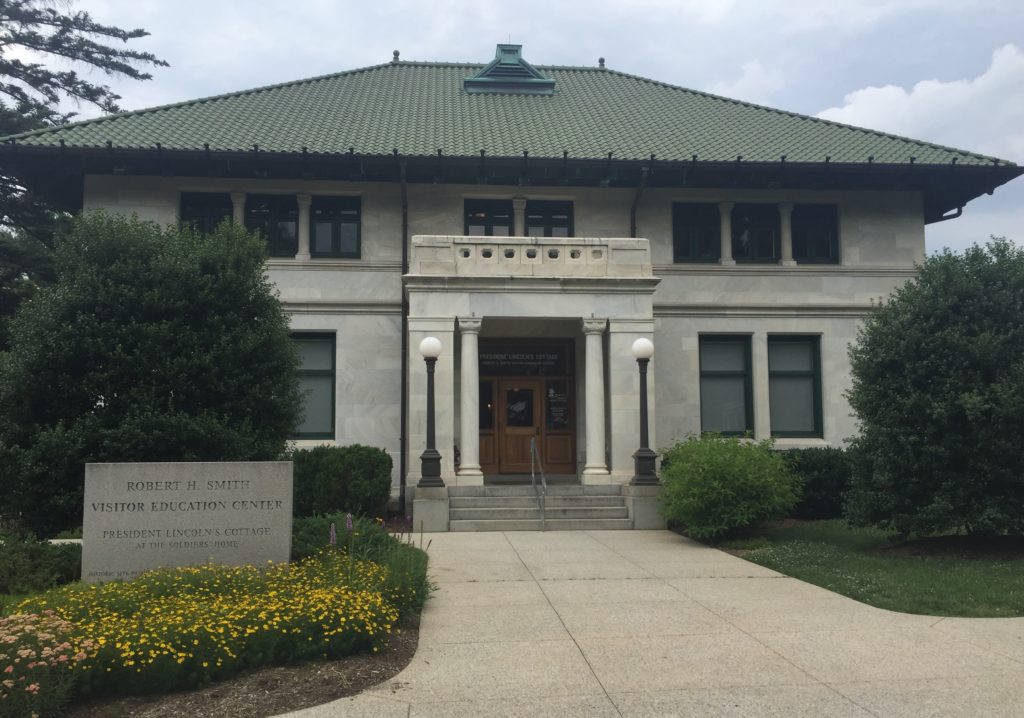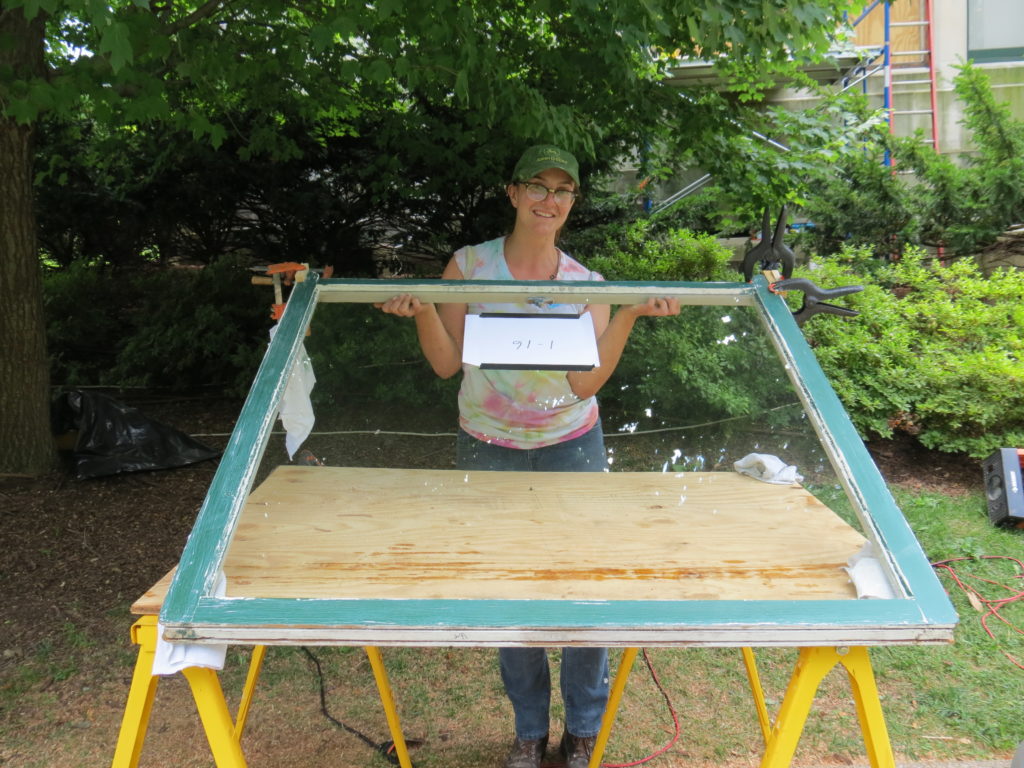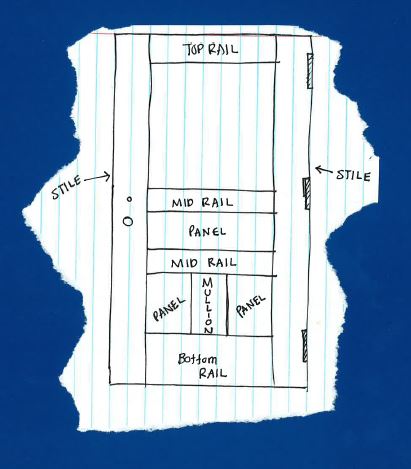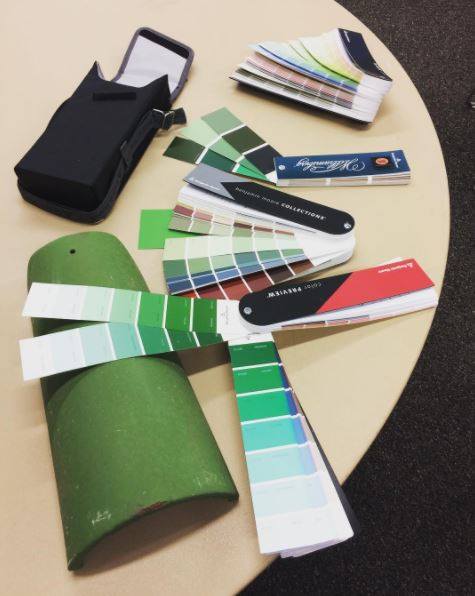
The Robert H. Smith Visitor Education Center, June 2017
This summer the Robert H. Smith Visitor Education Center (VEC) will be seeing a lot of changes. Senior Preservationist Jeff Larry, with help from summer preservationist intern Morgan Graff, will be working on preserving the doors and windows of the 1905 Italian Renaissance Revival style building. Designed by William Poindexter, the structure was originally built in 1905 to serve as the Administration Building for the Soldiers’ Home. Today it is home to President Lincoln’s Cottage’s exhibits, Museum Store, and administrative offices.
The Visitor Education Center is also the first at a National Trust Historic Site to receive Leadership in Energy and Environmental Design (LEED) Certification from the U.S. Green Building Council. The Robert H. Smith Visitor Education Center received 44 credits, earning LEED Gold certification in April 2009.
We sat down with Morgan Graff, the Preservation Intern, to discuss the project’s details, her background, and why on Earth she’s here at 7 AM.

Morgan working on one of the windows from the Visitor Education Center
Morgan, explain your background and how you first heard of this opportunity:
I graduated from UMW (University of Mary Washington) in 2014 with a Bachelor’s Degree in Historic Preservation, specializing in architectural conservation and documentation (not a specified specialization but enrolled in classes that were oriented towards architectural conservation and documentation). After undergrad I realized that I wanted to learn and understand more of the trade side of preservation and how to physically apply the theoretical aspect of architectural conservation to historical buildings and their fabric. I found Belmont College, located in St. Clairsville, OH which was relatively close to my home in Pittsburgh but also well-known in the preservation community for being a reputable trade school that delved in multiple facets of building material conservation such as stained glass, windows & doors, roofing & flooring, metals, plaster, understanding of wood and woodworking tools and providing classes in research & documentation, a class teaching the different phases of American Architecture and Drafting. Since my undergrad degree covered the majority of the theoretical preservation classes I was able to focus more on the different preservation of building materials that you would typically encounter. Through that program I received an Associates in Building Preservation and Restoration and was able to network with some preservation companies located within the Ohio Valley. One being Adventures in Elegance where I was employed as a Preservation Plasterer working on interior plaster flatwork and exterior stucco work and a company called Allegheny Restoration which focuses in Preservation Contracting where they travel to various sites for different aspects of restoration/preservation. My job included performing window preservation at an early 1900 post office building.
I was at school when I noticed that one of my Professors posted a flyer for this internship and I was more than willing to apply. When Jeff called me to inform that I was chosen for the internship I was thrilled to accept this wonderful opportunity. My goal for this internship is to gain experience applying my education from UMW and Belmont to a historic house museum setting or an architectural preservation firm as a consultant through the projects here, my newly acquired skills and Jeff’s guidance and teaching.
Can you sum up your role here at the Cottage, and the work you’ll be doing on the VEC this summer?
I am the Preservation Intern under the supervision of the Senior Preservationist, Jeff Larry. My role for this summer is to assist Jeff with window and door removal for repairs and refinishing, window & door trim repairs, shutter repairs (I will be performing this task normally but when it’s raining where I won’t be able to work on the door) and disassembling and repairing the last original door of the Visitor Center (1905). Also to learn the day to day management of a historic site.
Jeff is currently working on the window trim of the Visitor Center, while he assigned me to work on the west facing original exterior door from 1905. The door is a ½” quarter sawn white oak veneered over 1 ½” pine. The door consists of a lock stile and hinge stile, top rail, bottom rail, two middle rails with a panel partitioning the middle rails, a mullion which vertically partitions two panels on either side. It also has glazing (one window pane) between the top and middle rail. Once we disassembled the door we were able to figure out the condition of the door and what areas needed attention. The lock stile was warped, the bottom of the hinge rail and mortise pockets were rotten, the bottom rail’s veneer didn’t match the white oak, tenons were choppy tiny strips of glued up mahogany and the tenon that connects the mullion and bottom rail was rotten. Jeff and I decided to replicate the bottom rail using new mahogany for the tenons and interior body of the door and new white oak for the veneer to match the same size and design as the “insensitive” previous repair of the bottom rail. The mullion tenon was replaced by removing the rot with a dado blade on a table saw and incorporating a new white oak tenon piece. The hinge stile was rotten at the bottom. Pieces of the bottom of the stile were removed and replaced with mahogany which was liquid epoxied in place. After that dries we intend to create a new mortise pocket. The lock stile’s veneer was removed and planed down to the proper thickness. The interior pine body will be replaced through a glue up of two pine boards, cutting to proper size and creating new mortise pockets that match the original stile. After the door has been completed we will refinish the pieces and then reassemble. I have already lightly sanded the UV damage from the exterior veneer and conditioned them with 50/50 wood conditioner mixture consisting of turpentine and boiled linseed oil.

Inside a preservationist’s notebook: “the door”
Wow, that’s a lot of preservationist terms there. Can you walk me through a typical work day?
I arrive around 6:45-7 AM to normally avoid the heat, which is a typical start time when the majority of your work is outside. I start off by setting up the tools and getting ready for the tasks that Jeff and I have planned for the day and continue working on the previous day’s work. Jeff has been supervising me nearby while he is working on the window trim and frequently checks in to answer any questions and solve any problems I might be having on my current project that he’s letting me do as much as possible on my own. We then discuss the next steps and plans for the current project and future projects this summer. If it’s a rainy day, my duty will be to repair the Cottage shutters. The shutters are reproductions from 2005 and a few of the eye screws have become loose and need to be replaced since they receive the Hook and Staple Tieback (shutter dog). The shutter dogs secures and holds the shutters open. If the area around the eye screw is rotted then the area is repaired by removing the rot and applying liquid and putty epoxy to fill in the holes. Some of the shutter fins have been damaged as well and can be repaired with same epoxy application. After the epoxy has hardened and cured (normally 24 hours) a new hole can be drilled for a retrofitted spring loaded pin which holds the fins in place and assists with the repairs without disassembling the shutters.
I’m excited to see what other projects arise in the upcoming weeks that I am here and the new knowledge and techniques that I will gain from Jeff.
Tell me about your dream job in preservation?
Honestly, this. I’d like to be at a Museum site and come up with preservation plans.
Is there a time period’s decor/design/architecture that you enjoy the most?
Victorian. I love all the artistry, the details. Colonial is beautiful, but Victorian — it’s the increased detailing they add to the finishes. Decorative care, it’s really beautiful.
What’s one of your favorite structural components to the Cottage?
I love the windows. The jib doors, that open up to go onto the veranda, they’re wonderful.
What’s one of the largest misconceptions about historic preservation work? Do people just not know what you do?
Yep, people often mistake it for archaeology. People think you’re digging all day. Paleontology, too, actually! They think I’m digging up dinosaur bones. I think people don’t realize how much of a process it can be to preserve things. It takes a lot of research, time, effort. For example, when you’re trying to repaint a window you don’t just choose a pretty color you like. You need to do a paint analysis first. Kind of like what Jeff did for the windows. You also need to look at original blueprints, or design. A lot goes into it that people don’t think about.

A paint analysis of previous paint layers on the trim show that over the past one hundred years most of the layers are varying shades of green.
Morgan is the summer preservation intern for ten weeks. Spot her, in her tie-dye, on the back lawn, in the basement of the Cottage, or roaming the grounds where she’ll be sawing, conditioning, measuring, cutting, and everything other than digging under dinosaur bones. Stop by and say hello, and ask her about how she built a wooden tiny door, and what she’s going to do with it.
